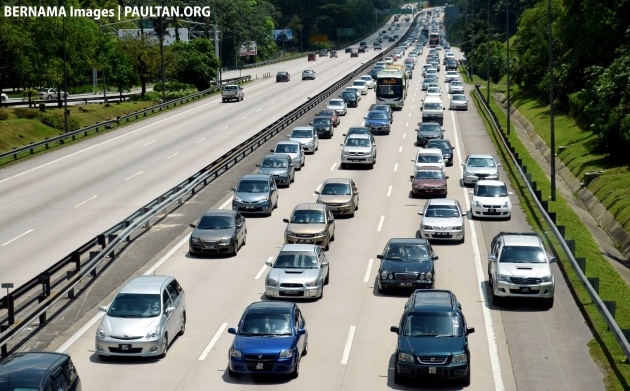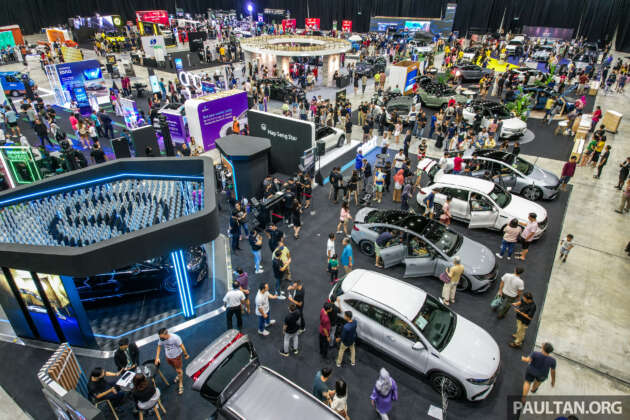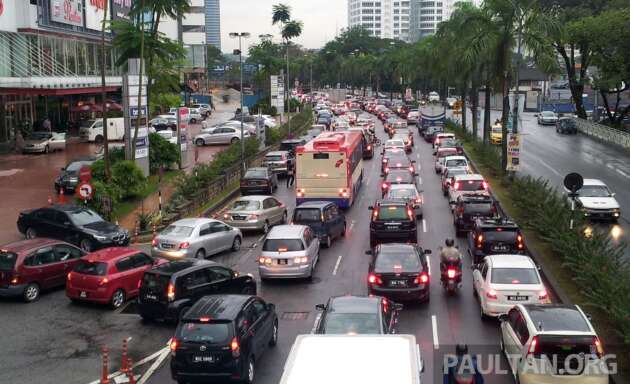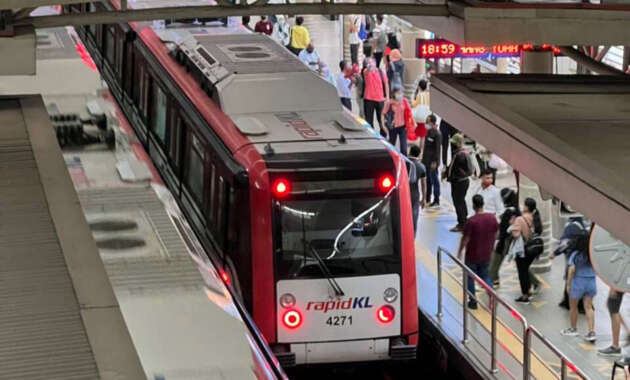The issue of growing traffic congestion requires policies which discourage the use of private vehicles, alongside improvements toward the public transport ecosystem, said experts according to The Star.
Most people, especially those living outside the city centre, prefer driving as it is more convenient compared to taking public transport where switching transit lines is required, said Malaysian Institute of Road Safety Research (Miros) chairman Wong Shaw Voon.
An example cited by The Star is a commuter in Selangor who travels from Kota Damansara to SS15 in Subang Jaya, who will first need to travel to the Muzium Negara MRT station, and change lines at the KL Sentral LRT station.
“This doubles the travel time compared to driving. Public transport still has limited lines. More improvement is needed if we want more people to use public transport,” Wong said, noting that the situation may improve with the upcoming MRT 3 (Circle Line) and LRT 3 (Bandar Utama – Klang line) rail projects.
Citing data from the road transport department (JPJ), new vehicle registrations increased from 530,057 units in 2021 to 832,347 units in 2023, according to the report.
Meanwhile, the lack of first- and last-mile connectivity is the main reason people prefer owning vehicles, said MDS Consultancy Group managing director Rosli Azad Khan, according to The Star.
Transit alignments are often located far away from residential areas, and seamless interconnectivity across different modes of public transport is a must if private vehicle use is to be discouraged. Having more interchange stations where commuters can easily switch train lines, along with a single payment platform and smaller feeder buses, as well as allowing e-mobility vehicles on the trains can help, he said.
“Digital ticketing systems to enable a single payment platform across all modes of public transport such as MyRapid and other cashless systems can contribute to seamless journey. To shorten transfer times, smaller buses or minibuses can be used to ferry commuters from their housing areas to the transit stations,” Rosli said.
“Car restriction measures, for instance higher toll rates for highways running in the cities such as Kuala Lumpur, Petaling Jaya, Subang, Shah Alam and Klang, must be in place. Parking areas in the cities should be limited. Cars should also not be allowed to park on the road,” Rosli added, calling for policy changes to restrict private car usage.
According to Malaysia Road and Transportation Safety Association president Nik Mohd Salim, traffic conditions are expected to worsen as more development arises, but there are fewer plans to increase road access, The Star wrote.
“Housing areas should centre around public transport hubs,” Nik Mohd Salim said, who urged the government to consider traffic issues in their city planning, and that there needs to be better access to public transport from housing areas.
Meanwhile, new transit lines technology and greater investment in public transport have been proven to attract commuters, said Malaysian Public Transport Users Association president Ajit Johl according to the report.
“We will see a reduction in traffic jams provided the government plays an active role in the continued promotion of the public transportation system,” said Ajit, who suggested that the city implements car-free days on weekdays.
Looking to sell your car? Sell it with Carro.















these so called experts no nothing. car free days? sure. can our MRT handle the passengers load? as of now its pretty congested already unless they are planning to implement tokyo style sardine can push ppl into train
maybe better, force the companies to allow employees to work from home instead of them having to waste time travelling to the office to pretend to work
ya, toll fare should be 5x higher – Pakar
Traffic jam is due to: 1. bad road design 2. bad public transport
Instead of solving the main problems, you go and add more burdens to the rakyat? Why are the government so useless?
The gov won’t have the nuts to implement any of those. Only possible one is a forced 2 days per week work from home rotation probably.
well whats new, prices of everything going up. No need for those changes, just wait RON95 rm3. above charges only benefit concessionaires, developers (parking regulation ratio).
traffic would reduce with WFH policies or staggered 4day work. Actually multiples solutions which does not involve consumers money but approaching the solution through monetary enforcement is kinda low sighted even a highschool student could write an essay about it.
Actually Klang Valley public transport connectivity has improved a lot compared to 10 years ago. But many people choose to drive even if their house is only 500m away from train station and nearest train stations to office is about 500m. People are blaming on public transport and rationalise themselves to own a car.
And another problem people don’t take public transport except the car itself not cheap, any other expenses on car related are cheap. Public parking is super cheap in Malaysia, toll fares cheap, petrol price top 10 cheapest in the world (cheaper than Saudi), car maintenance is cheap etc.
Gov need to impose high parking fees in KL area and also limit to 3 hours parking only. Raise toll fares around Klang Valley area.
Am I sound cruel? Do you guys know there were many people mismanage their financial primarily is on car loan. Car loan is the 2nd largest cause of bankruptcy in Malaysia. If one bankrupt due to business closure it is understandable but not on car loan.
Actually these people want government to improve public transport but they not going to use it instead they’re hoping others to use it so the road will be less congested for to drive , typical Malaysian Mentaliti
I’m Klantanese and now live in Klantan. I was living in Bangi 20 years ago, and travelling from Bangi to Gombak Toll during evening rush hours would take like 5:30 pm-8 pm. But my recent visit was, I started driving from Putrajaya at 5:30 pm and arrived at Gombak Toll at 6:45 pm. I said these 4-story KL highways are really a wonder! So what are these experts complaining about?
till the day all ministers drive themselves, don’t give shit to the ppl.
Must change the mentality first.
Now every manager drives to work at KL, its a disgrace to take public transportation.
As above or is it janji dicapati?
Banjir more important also cannot solve, want to solve traffic jam?
Kota Damansara can took Bus 807 from mrt Surian, freq every 20 min one by bus, toward lrt Lembah Subang, swap to lrt toward ss15 station
Bro, these are thousand of dumbaxs pretend not seeing your comment. They just want everyone agree that public transport in KV is sxck big time and they have valid reason to own a car. Gov already trying their best to give free bus to station and also myrapid RM50 monthly pass for unlimited ride of rapid public transport include trains and bus. But still there are thousands of ego fella choose to drive despite the car instalment and expenses are burdening them. When comes to change tyre choose the cheapest or second hand tyre that may have safety issue, delay repair of car that may breakdown on the busy road give hassle to other road users. Poor financial mindset with high enjoyment and desire of buying car beyond their capability cause them struggle in life.
cmon this so called expert, Thai, Indon and many more countries their cost of car ownership is higher than here, especially their petrol price, but still jam, y?? the real prob is too many cars on the road. Need to hv car scrapping policy for vehicles tht over 20yrs old. Reduce loan to max 7yrs and 20% dpayment, then u will see the decline. Only then, ppl will use public transport. And also, lesser breakdown of old vehicles that causes jam.
Government should allocate those ev taxcredit/incentive(if that is still exist) into our public transportation system. Stop worshipping the ap holders. Let the auto industry do whatever things they want to do without government backing. If they want to exit, just go ahead. If they go bankrupt then that is their problem. For years non-chinese automakers have been belittle Malaysia by offering their products with mediocre specs.
Shut up lah “expert”
Provide better connection and more efficient public transport! Puncak alam, kuala langat, kuala selangor (to name a few)
its the volume of cars sold. u dont need to jack up toll fares or parking or petrol, Gov simply need to change the eligibility to buy car. For eg, prove that you have a valid parking spot to fit the car first. but than, Gov earn money from car tax, so dream on.
If public transport is efficient, who will buy cars and how will the motor industry that is one of the highest taxpayers to gomen will survive? These are all just smoke and mirrors. Also how to stay in the city or even around the city when prices of properties and rentals are all time high despite the slow economy.
People will still buy cars for long distance travel. The real question is, who’s going to pay for all new highways they keep building EVERY YEAR if everybody use public transport.
Dude, are you serious on what you said? If yes then you are dumb. There are many high rise condo units available and located nearby MRT and LRT. 1000sqf rental is like 1.3k only. Even a small room it only cost you about RM500. If this consider high rental to you then you should think twice whether you suitable to live in KL or not. If one who stay 40km far landed township like Semenyih, Puncak Alam, Rawang etc then of course these places public transport not good because the population crowd and places pass by not justify to build LRT or MRT that cost billions.
I highly believe you are one of those who reluctant to take public transport coz enjoying driving car and when gov did something not favourable for driving then you yell.
if bangla,myanmar, pakistan can stay in the city, y local cant? bcoz want nicer housing theme area like Elmina but rent only to show off to fren & relative…then later said no public transport!!
I disagree with these experts view. Govt needs to be more frugal in managing the infrastructure project especially transportation. 2. Too many unsolved problems eg MRT with last mile connections, parking for cars at stations etc. 3. Transport related solutions are always looked at the bigger picture eg ToD city but never end to end solutions for the public who are the users and taxpayers funding them.
Yes. The solution is higher toll rates. That’s why they keep making more highways with tolls every year. More highway with expensive tolls = less traffic jams, right?!
why not all menteri try to go around car free for a month without police force opening road for them, and then they will suddenly know how to solve the traffic jam issue instead of coming up with these useless ideas
“Most people, especially those living outside the city centre, prefer driving as it is more convenient compared to taking public transport where switching transit lines is required, said Malaysian Institute of Road Safety Research (Miros) chairman Wong Shaw Voon.”
Wong, do you and your staff practice what you all preach?
Miros office is in Kajang, do you and your staff take public transport or do all of you drive to office?
Be honest to yourself!
Malaysian don’t like to walk…simple…
see so many double parking because they just want to rush to a shop…even though there are parking spots … 100 or 200 meters away….
1. Odd even vehicles policy to enter city or selected zones.
2. Fuel tax (↑+50% progressive rate).
Electronic Road Pricing (ERP) with GNSS and smartphone – congestion charge.
3. Reduce public & private parking space by 40% (especially in central business district) and transform to green space.
4. Centralised land traffic control to monitor & divert heavy vehicles with GNSS and smartphone (managed by APAD & JPJ).
5. No heavy vehicles & large size vehicles including SUV & 4×4 during peak hours within city limit and regular congested road.
6. Bus Rapid Transit (BRT) for Greater Kuala Lumpur with new 7,000 electric bus (various sizes) by 2027.
7. Hybrid work policy – 3 day in office, 2 day at home especially government & GLCs.
8. 2x – 3x/week commute with public transportation and or by motorcycle/bicycle policy by government and GLCs for non critical workforce.